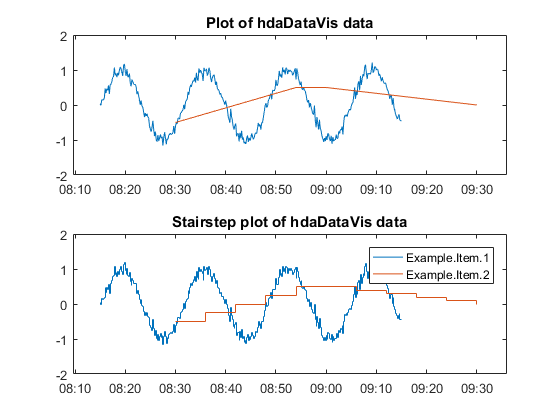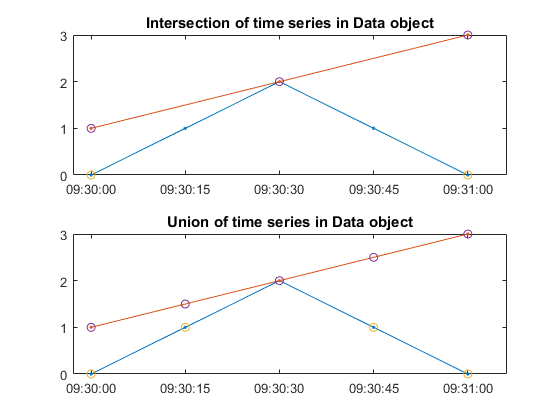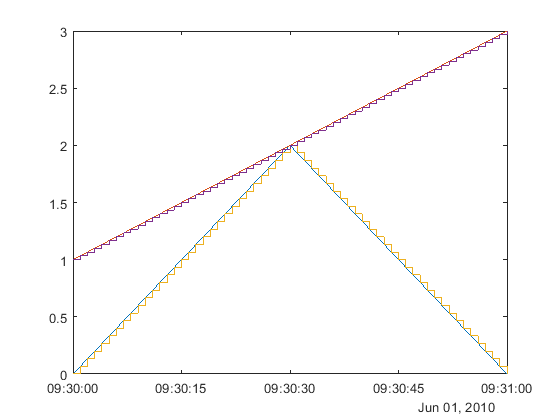Visualize and Preprocess OPC HDA Data
This example shows you how to work with OPC HDA Data objects.
You create OPC HDA Data objects when you read data from an OPC Historical Data Access (HDA) server. OPC HDA Data objects allow you to store, visualize, and manipulate historical data before converting that data to built-in data types for further processing in MATLAB.
For more information on generating OPC HDA Data objects, see the example Acquire Data from OPC Historical Data Access Server.
Load Sample OPC HDA Data
Load the sample data into the workspace.
load opcdemoHDAData
Display OPC HDA Data Objects
Examine the workspace to see the loaded variables.
whos
Name Size Bytes Class Attributes hdaDataSmall 1x2 252 opc.hda.Data hdaDataVis 1x2 8984 opc.hda.Data
Display a summary of the data contained in hdaDataVis.
hdaDataVis
hdaDataVis =
1-by-2 OPC HDA Data object:
ItemID Value Start TimeStamp End TimeStamp Quality
-------------- ----------------- ------------------- ------------------- ----------------------
Example.Item.1 361 double values 2010-05-12 08:15:00 2010-05-12 09:15:00 1 unique quality [Raw]
Example.Item.2 11 double values 2010-05-12 08:30:00 2010-05-12 09:30:00 2 unique qualities
The data object contains two items. The first element Example.Item.1 contains 361 values and one unique quality, while the second has 11 values and two unique qualities.
Examine the second element in more detail using the showValues function.
opc.setDateDisplayFormat('yyyy-mm-dd HH:MM:SS');
showValues(hdaDataVis(2))
OPC HDA Data object for item Example.Item.2:
TIMESTAMP VALUE QUALITY
=================== ============= =================
2010-05-12 08:30:00 -0.500000 Raw (Good)
2010-05-12 08:36:00 -0.250000 Raw (Good)
2010-05-12 08:42:00 0.000000 Raw (Good)
2010-05-12 08:48:00 0.250000 Raw (Good)
2010-05-12 08:54:00 0.500000 Calculated (Good)
2010-05-12 09:00:00 0.500000 Calculated (Good)
2010-05-12 09:06:00 0.400000 Calculated (Good)
2010-05-12 09:12:00 0.300000 Raw (Good)
2010-05-12 09:18:00 0.200000 Raw (Good)
2010-05-12 09:24:00 0.100000 Raw (Good)
2010-05-12 09:30:00 0.000000 Raw (Good)
Change Date Display Format
Get the current date display format using opc.getDateDisplayFormat.
origFormat = opc.getDateDisplayFormat;
Change the display format to standard US date format and display the value again.
opc.setDateDisplayFormat('mm/dd/yyyy HH:MM am');
showValues(hdaDataVis(2))
OPC HDA Data object for item Example.Item.2:
TIMESTAMP VALUE QUALITY
===================== ============= =================
05/12/2010 8:30 AM -0.500000 Raw (Good)
05/12/2010 8:36 AM -0.250000 Raw (Good)
05/12/2010 8:42 AM 0.000000 Raw (Good)
05/12/2010 8:48 AM 0.250000 Raw (Good)
05/12/2010 8:54 AM 0.500000 Calculated (Good)
05/12/2010 9:00 AM 0.500000 Calculated (Good)
05/12/2010 9:06 AM 0.400000 Calculated (Good)
05/12/2010 9:12 AM 0.300000 Raw (Good)
05/12/2010 9:18 AM 0.200000 Raw (Good)
05/12/2010 9:24 AM 0.100000 Raw (Good)
05/12/2010 9:30 AM 0.000000 Raw (Good)
Reset the display format to the original value.
opc.setDateDisplayFormat(origFormat);
Visualize OPC HDA Data
Visualize OPC HDA Data using the plot and stairs functions on the data object.
figure; axH1 = subplot(2,1,1); plot(hdaDataVis); title('Plot of hdaDataVis data'); axH2 = subplot(2,1,2); stairs(hdaDataVis); title('Stairstep plot of hdaDataVis data'); legend show

Resample OPC HDA Data
Examine a small data set. This data set is intentionally small to show the concept of resampling.
hdaDataSmall
hdaDataSmall =
1-by-2 OPC HDA Data object:
ItemID Value Start TimeStamp End TimeStamp Quality
--------------- --------------- ------------------- ------------------- ----------------------
Example.ItemR.1 5 double values 2010-06-01 09:30:00 2010-06-01 09:31:00 1 unique quality [Raw]
Example.ItemR.2 3 double values 2010-06-01 09:30:00 2010-06-01 09:31:00 1 unique quality [Raw]
Display the data from each item individually. You cannot display the items in one table because their time stamps are not the same.
showValues(hdaDataSmall(1)) showValues(hdaDataSmall(2))
OPC HDA Data object for item Example.ItemR.1:
TIMESTAMP VALUE QUALITY
=================== ============= ==========
2010-06-01 09:30:00 0.000000 Raw (Good)
2010-06-01 09:30:15 1.000000 Raw (Good)
2010-06-01 09:30:30 2.000000 Raw (Good)
2010-06-01 09:30:45 1.000000 Raw (Good)
2010-06-01 09:31:00 0.000000 Raw (Good)
OPC HDA Data object for item Example.ItemR.2:
TIMESTAMP VALUE QUALITY
=================== ============= ==========
2010-06-01 09:30:00 1.000000 Raw (Good)
2010-06-01 09:30:30 2.000000 Raw (Good)
2010-06-01 09:31:00 3.000000 Raw (Good)
Attempt to convert the data to a double array. The conversion will fail.
try vals = double(hdaDataSmall); catch exc disp(exc.message) end
Conversion to double failed. All elements of the OPC HDA Data object must have the same time stamp. Consider using 'TSUNION' or 'RESAMPLE' on the Data object.
The intersection of the items' time stamps results in a smaller, regularly sampled data set.
hdaDataIntersect = hdaDataSmall.tsintersect
hdaDataIntersect =
1-by-2 OPC HDA Data object:
ItemID Value Start TimeStamp End TimeStamp Quality
--------------- --------------- ------------------- ------------------- ----------------------
Example.ItemR.1 3 double values 2010-06-01 09:30:00 2010-06-01 09:31:00 1 unique quality [Raw]
Example.ItemR.2 3 double values 2010-06-01 09:30:00 2010-06-01 09:31:00 1 unique quality [Raw]
Use the showValues method to display all values.
Show these values together. You can do this because the time stamps are now regularly sampled.
showValues(hdaDataIntersect)
OPC HDA Data object array:
TIMESTAMP Example.ItemR.1 Example.ItemR.2
=================== =============== ===============
2010-06-01 09:30:00 0.000000 1.000000
2010-06-01 09:30:30 2.000000 2.000000
2010-06-01 09:31:00 0.000000 3.000000
Convert the data object into a double array.
vals = double(hdaDataIntersect)
vals =
0 1
2 2
0 3
Use tsunion to return the union of time series in a Data object. New values are interpolated using the method supplied (or linear interpolation if no method is supplied).
hdaDataUnion = hdaDataSmall.tsunion showValues(hdaDataUnion)
hdaDataUnion =
1-by-2 OPC HDA Data object:
ItemID Value Start TimeStamp End TimeStamp Quality
--------------- --------------- ------------------- ------------------- ----------------------
Example.ItemR.1 5 double values 2010-06-01 09:30:00 2010-06-01 09:31:00 1 unique quality [Raw]
Example.ItemR.2 5 double values 2010-06-01 09:30:00 2010-06-01 09:31:00 2 unique qualities
Use the showValues method to display all values.
OPC HDA Data object array:
TIMESTAMP Example.ItemR.1 Example.ItemR.2
=================== =============== ===============
2010-06-01 09:30:00 0.000000 1.000000
2010-06-01 09:30:15 1.000000 1.500000
2010-06-01 09:30:30 2.000000 2.000000
2010-06-01 09:30:45 1.000000 2.500000
2010-06-01 09:31:00 0.000000 3.000000
Note how the quality is set to "Interpolated" for those new values in Example.ItemR.2.
showValues(hdaDataUnion(2))
OPC HDA Data object for item Example.ItemR.2:
TIMESTAMP VALUE QUALITY
=================== ============= ===================
2010-06-01 09:30:00 1.000000 Raw (Good)
2010-06-01 09:30:15 1.500000 Interpolated (Good)
2010-06-01 09:30:30 2.000000 Raw (Good)
2010-06-01 09:30:45 2.500000 Interpolated (Good)
2010-06-01 09:31:00 3.000000 Raw (Good)
Plot the data with markers to show how the methods work.
figure; subplot(2,1,1); plot(hdaDataSmall,'Marker','.'); hold on plot(hdaDataIntersect,'Marker','o','LineStyle','none'); title('Intersection of time series in Data object'); subplot(2,1,2); plot(hdaDataSmall,'Marker','.'); hold on plot(hdaDataUnion,'Marker','o','LineStyle','none'); title('Union of time series in Data object');

Resample the small data set at specified time steps.
timeRange = datetime(2010,6,1,9,30,0:10:60);
fixedPoint = datetime(0, 1, 0);
newTS = days(timeRange - fixedPoint);
hdaDataResampled = resample(hdaDataSmall,newTS)
figure;
plot(hdaDataSmall);
hold on
stairs(hdaDataResampled);
hdaDataResampled =
1-by-2 OPC HDA Data object:
ItemID Value Start TimeStamp End TimeStamp Quality
--------------- ---------------- ------------------- ------------------- ------------------
Example.ItemR.1 61 double values 2010-06-01 09:30:00 2010-06-01 09:31:00 2 unique qualities
Example.ItemR.2 61 double values 2010-06-01 09:30:00 2010-06-01 09:31:00 2 unique qualities
Use the showValues method to display all values.
